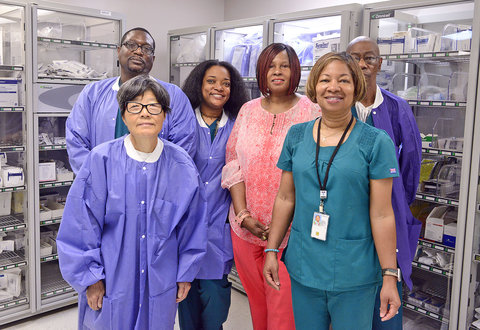Dedicated, Motivated, Safe and Sterile

Cassandra Williams, MSN, RN is currently the chief of sterile processing service. Members of the CAVHCS SPS team from left to right. Front row: Hui Osborn, lead technician and Cheryl Owens, MSN, RN, RME coordinator/educator. Second row: Eldon Prince, technician, Betty Boswell, technician, Cassandra Williams, MSN, RN, chief and Charles Curry, technician. Staff not available for picture: Christopher McDaniel and Gary Smith, sterile processing technicians.
The Sterile Processing Service (SPS) at the Central Alabama Veterans Healthcare System (CAVHCS) is a dedicated team of professionals in the trenches of the patient safety improvement effort throughout the Veterans Health Administration (VHA).
The SPS team collaborates with departments and clinics throughout the facility in supporting the usage of Reusable Medical Equipment (RME). SPS not only supports West Campus (Montgomery) and East Campus (Tuskegee); they also serve community-based outpatient clinics throughout Alabama and several specialty services such as dental, podiatry, optometry, women’s health, sleep lab, the operating room and urology.
Staff commitment and the utilization of best practices play a key role in this effort. Although certification is optional, 70 percent of CAVHCS SPS employees maintain professional certification. SPS technicians are also intentional in keeping up with the expeditious pace of technological advances in health care, the dynamic equipment they use, as well as increased demands of their customers.
Due in part to the increasing complexity of device designs and components,1 the Food and Drug Administration (FDA) requires cleaning validation studies of each device from the device’s manufacturer, to ensure adequate reprocessing of complex device designs and components.
The RME Coordinator provides education about the RME regulations and its process, while the SPS staff ensures the departments have adequate numbers and types of equipment and supplies necessary to perform direct patient care activities. Oversight is provided by the VHA National Program Office for Sterile Processing2 and Veterans Integrated Service Network 7, which includes unannounced site visits at random intervals and internal quality monitoring in all areas where RME items (instruments and equipment) are cleaned.
During the surgical instrumentation cleaning process, SPS staff conducts 100 percent occult blood tests on all colonoscopies. This test checks for blood (hemoglobin) residue inside a flexible endoscope, prior to the sterilization/disinfection process, and is one way in which the SPS team contributes to the larger patient safety effort throughout VHA.
Another safety priority SPS adheres to is upholding the goal of “0” percent use of Immediate Use Steam Sterilization (IUSS). IUSS describes steam sterilization cycles in which unwrapped medical instruments are subjected to an abbreviated steam exposure time and then used promptly after cycle completion. The ability to maintain adequate par levels of all sterile processing supplies help facilitate the decreased need for IUSS sterilization.
The SPS department also utilizes the Censitrac instrument tracking system, which is a web-based software solution focused on maximizing SPS efficiency through the management and tracking of instruments processed through SPS. The best practices mentioned help create positive patient outcomes for Veterans receiving care at CAVHCS by ensuring that our customers receive the right instruments, at the right time, in the right condition.
References
- George Sheffield. “Responsibilities for Effective Medical Device Reprocessing Procedures and Instructions.” Biomedical Instrumentation & Technology 46, no. 12 (2012): pp. 76-79.
- Department of Veterans Affairs. “Sterile Processing Services”, (2016) VHA Directive 1116(1).



















